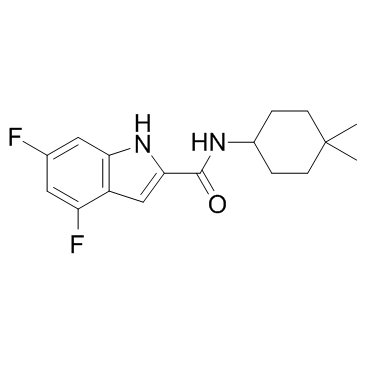| Description |
NITD-349 is an MmpL3 inhibitor that shows highly potent anti-mycobacterial activity with MIC50 of 23 nM against virulent Mycobacterium tuberculosis H37Rv.
|
| Related Catalog |
|
| Target |
MIC50: 23 nM (Mycobacterium tuberculosis H37Rv)[1]
|
| In Vitro |
NITD-349 shows bactericidal activity against in vitro replicating Mycobacterium tuberculosis (Mtb) and also are active against intramacrophage Mtb. Kill kinetic analysis of these compounds showed both concentration- and time-dependent killing of Mtb cells with 3- to 4-log colony-forming unit (CFU) reductionwithin 3 days of treatment. The cidal activity profile of NITD-304 is similar to that of isoniazid for which rapid killing is noticed at concentrations greater than 0.2 μM. The MIC activity of NITD349 against various MDR Mtb strains ranges from 0.04 to 0.08 μM. NITD-349 shows high permeability and moderate in vitro metabolic clearance in mouse and human hepatic microsomes[1].
|
| In Vivo |
In the acute murine efficacy modelNITD-349 shows favorable oral pharmacokinetic (PK) properties in rodents and dogs and are efficacious in mouse models of both acute and chronic Mycobacterium tuberculosis infection. In the acute murine efficacy model, treatment of mice with NITD-349 at doses of 12.5 and 50 mg/kg resulted in 0.9- and 3.4-log CFU reduction in lung tissue. In an established infection mouse model, after 2 weeks of treatment, the efficacy of NITD-349 is comparable to the first-line TB drug rifampicin and is better than ethambutol. Four weeks of treatment at 100 mg/kg with NITD-349 results in 2.38-log CFU reductions[1].
|
| Cell Assay |
For determining growth inhibition against nine diverse MDR Mtb clinical isolates, pellet formation method is used. MIC is defined as the minimum concentration of the drug required to inhibit 50% of H37Rv growth or 99% of growth in MDR clinical isolates after 5 or 10 days of incubation, respectively. Five milliliters of H37Rv culture (1 × 107 CFU/mL) is incubated with varying concentrations of NITD-349 for 6 days at 37°C, and an aliquot of culture is plated onto Middlebrook 7H11 agar plates; the CFU are enumerated after incubating plates for 3 weeks in a 37°C incubator[1].
|
| Animal Admin |
Mouse: In the acute murine efficacy model, mice are orally treated with a daily dose of NITD-349 (12.5, 25, 37.5, 50 mg/kg) for 4 weeks, 1 week after intranasal infection with low-dose Mtb (1000 CFU). Bacterial load in lungs (mean ± SD from six mice per group and per time point) is analyzed after treatment by enumerating CFU[1].
|
| References |
[1]. Rao SP, et al. Indolcarboxamide is a preclinical candidate for treating multidrug-resistant tuberculosis. Sci Transl Med. 2013 Dec 4;5(214):214ra168.
|
